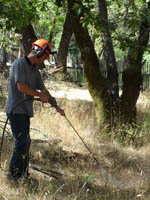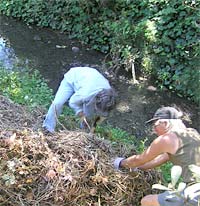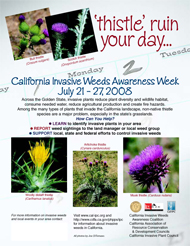California Invasive Weeds Awareness Week (CIWAW) is an annual event that brings attention to the problems caused by invasive plants in California, and to the work of local groups that work to protect our natural areas and rangelands. In 2004, the state legislature signed a proclamation declaring California Invasive Weeds Awareness Week to begin the third Monday of July each year. CIWAW is an excellent occasion for WMAs and other local groups to hold public awareness events and to visit the offices of elected representatives to let them know about local weed projects.
To help you organize activities for Weed Week, Cal-IPC has prepared a How-To Guide of Weed Week Strategies (Word) with event ideas, examples of press releases and county resolutions, tips for taking local legislators on a tour, and information on organizing community work days. (Unfortunately, we no longer have staff time available to post events on our web page.)
Past CIWAW Highlights

Demonstrating new technologies for controlling invasive plants.
Groups around the state used a variety of programs to educate local citizens on invasive plants. The following is a sample of events from previous California Invasive Weeds Awareness Weeks.
-
Friends of Five Creeks volunteers removed invasives along Cerrito Creek at the foot of Albany Hill, Alameda County
-
The Lake County Weed Management Area hosted its 5th annual “Invasive Weeds Tour”. The tour began in Lakeport, proceed to Nice, Rodman Slough, Kelseyville and end at Lakeside Park to observe the progress in controlling the invasive weeds and, in some cases, to see how rapidly the unattended invasive weeds have spread.
-
In Marin Councy, GGNRA taught beginner Weed Watcher how to monitor along trails and roadsides where new weed invasions often occur. They reviewed identification of priority plant species, as well as techniques for data collection and orienteering.
-
Also in Marin County the Salmon Protection and Watershed Network (SPAWN) removed invasive plant species such as French broom, vinca, and forget-me-nots in redwood and riparian ecosystem along Lagunitas creek to benefit wild salmon habitat. Lagunitas Creek Watershed is home to the largest remaining wild run of coho salmon in Central California.
-
The National Park Service’s Habitat Restoration Team spent the whole week working on invasive plants in Point Reyes National Park. They removed non-native, invasive oxeye daisy, Leucanthemum vulgare, and capeweed, Arctotheca calendula, from Lake Ranch and non-native, invasive capeweed, Arctotheca calendula, from Tomales Point. Each site offered magnificent views.
- hosted a hike on Rancho Cañada del Oro Open Space Preserve. Open Space Technicians were on hand to share their knowledge of invasive weeds and the struggle to contain them.
Here are some highlights from California Invasive Weeds Awareness Week, July 2008.
- Friends of Five Creeks, with the help of many volunteers, removed thornless blackberry (Rubus ulmifolius var. inermis) from El Cerrito’s Creekside Park, within Alameda County.
- Within El Dorado County the Lake Tahoe Basin Weed Coordinating Group hosted presentations on:
- The impacts of invasive aquatic and terrestrial weeds,
- What is being done to stop their establishement and spread, and
- How to stop their establishment and spread.
Below are examples of events from California Invasive Weeds Awareness Week, July 2006 & 2005.
- On the border of Alameda and Contra Costa Counties, Friends of Five Creeks held volunteer work parties on Cerrito Creek to tackle the explosion of bindweed (Convolvulus arvensis) that had completely covered about 70 feet of bank and was spreading downstream
- The Marin Municipal Water District and Marin/Sonoma Weed Management Area organized a workshop with demonstrations of “New Technologies to Control Invasive Weeds on Public Lands and Watersheds”.
- The San Luis Obispo County Weed Management Area sponsored a Board of Supervisors Resolution declaring July 17-23 Invasive Weed Awareness Week in San Luis Obispo County; published an article on the problems caused by invasive weeds in several local newspapers; and staffed a SLO County WMA display board at the Thursday night Farmer’s Market (one of the largest farmer’s markets in the State).
- The Mountains Recreation and Conservation Authority in the Santa Monica Mountains brought volunteers from their local REI store to remove weeds in Franklin Canyon.
- In Sonoma County, Russian Riverkeeper held a workday to remove invasive plants from riparian areas.
- The Tuolumne County portion of the Central Sierra Partnership Against Weeds presented a Noxious Weed Resolution to the Tuolumne County Board of Supervisors on July 17, 2006.

Friends of Five Creeks, Invasive Weeds Week 2005
- Friends of Five Creeks in Alameda County removed blackberries, Cape ivy, and other invasives — along with litter and shopping carts — from a derelict, weed-choked reach of Cerrito Creek.
- Lake Tahoe Basin Weed Coordinating Group sponsored a “Sweep Broom out of Tahoe” event. Because Scotch broom poses a threat to Lake Tahoe’s water quality and creates a fire hazard, the Lake Tahoe Basin Weed Coordinating Group asked Tahoe residents to uproot their Scotch broom plants and bring them in for a free replacement plant.
- Modoc County Weed Management Area held its annual weed tour focusing on four major A-rated noxious weeds, and a workshop for local backyard weed warriors focusing on “Pretty Weeds” that are very invasive.
- Redwoods National Park held a two-hour hike with some active manual control. The event was a front page story the next day. Park employees also gave two presentations at the visitor’s center on Scotch broom, periwinkle, English ivy, and Cape ivy.
- The Return of the Natives project at California State University-Monterey Bay held a community weed volunteer event in the creeks of Salinas.
- Santa Barbara County aired five programs on Santa Barbara County’s government access TV during July, focusing on arundo, brooms, pampas grass, and yellow starthistle.
- San Diego Chapter of the California Native Plant Society featured a presentation on the San Diego County Weed Management Area at its chapter meeting, while Carlsbad Watershed Network launched their “No Invasives In My Back Yard (NIIMBY)” program, with tours held at two weed removal sites to educate local residents.

